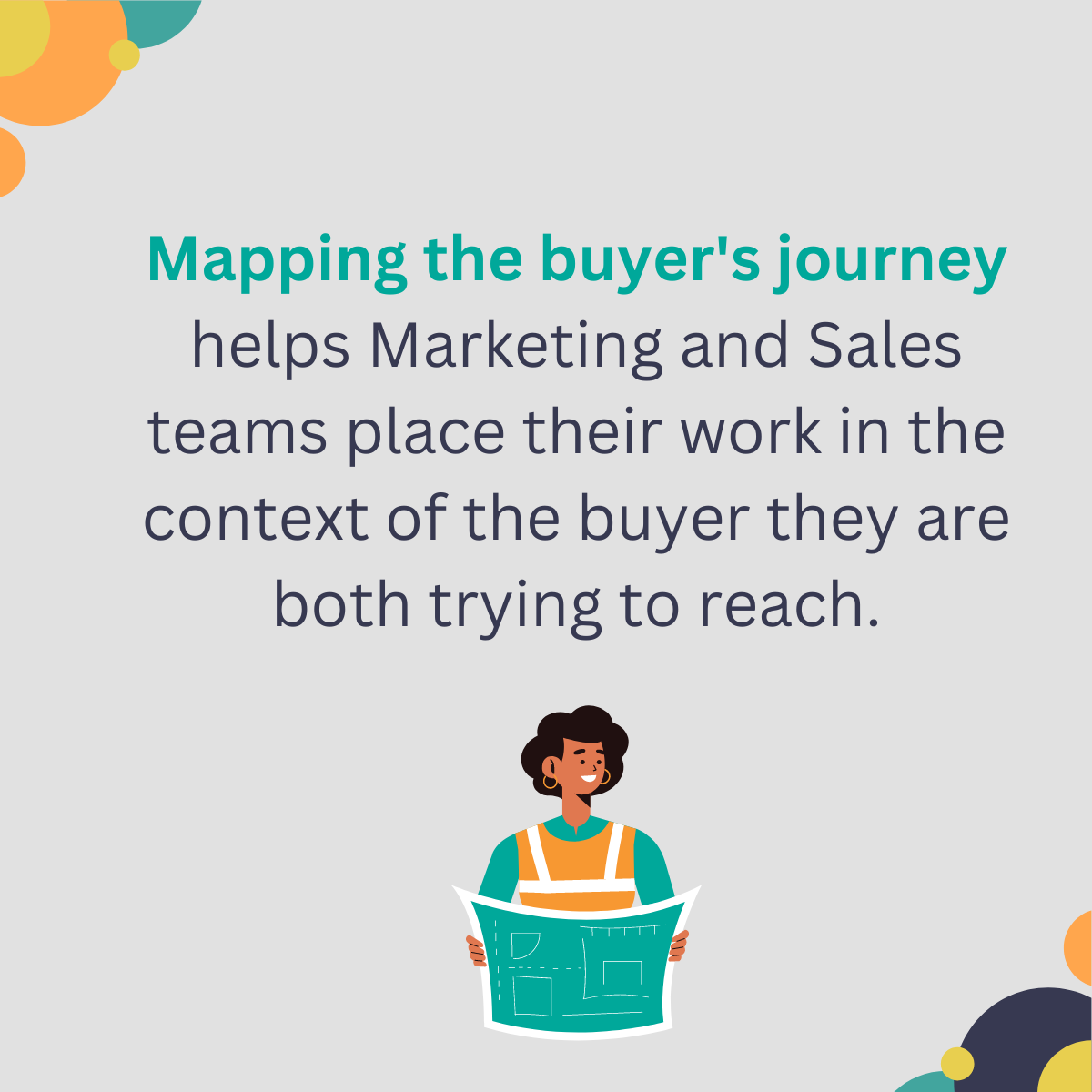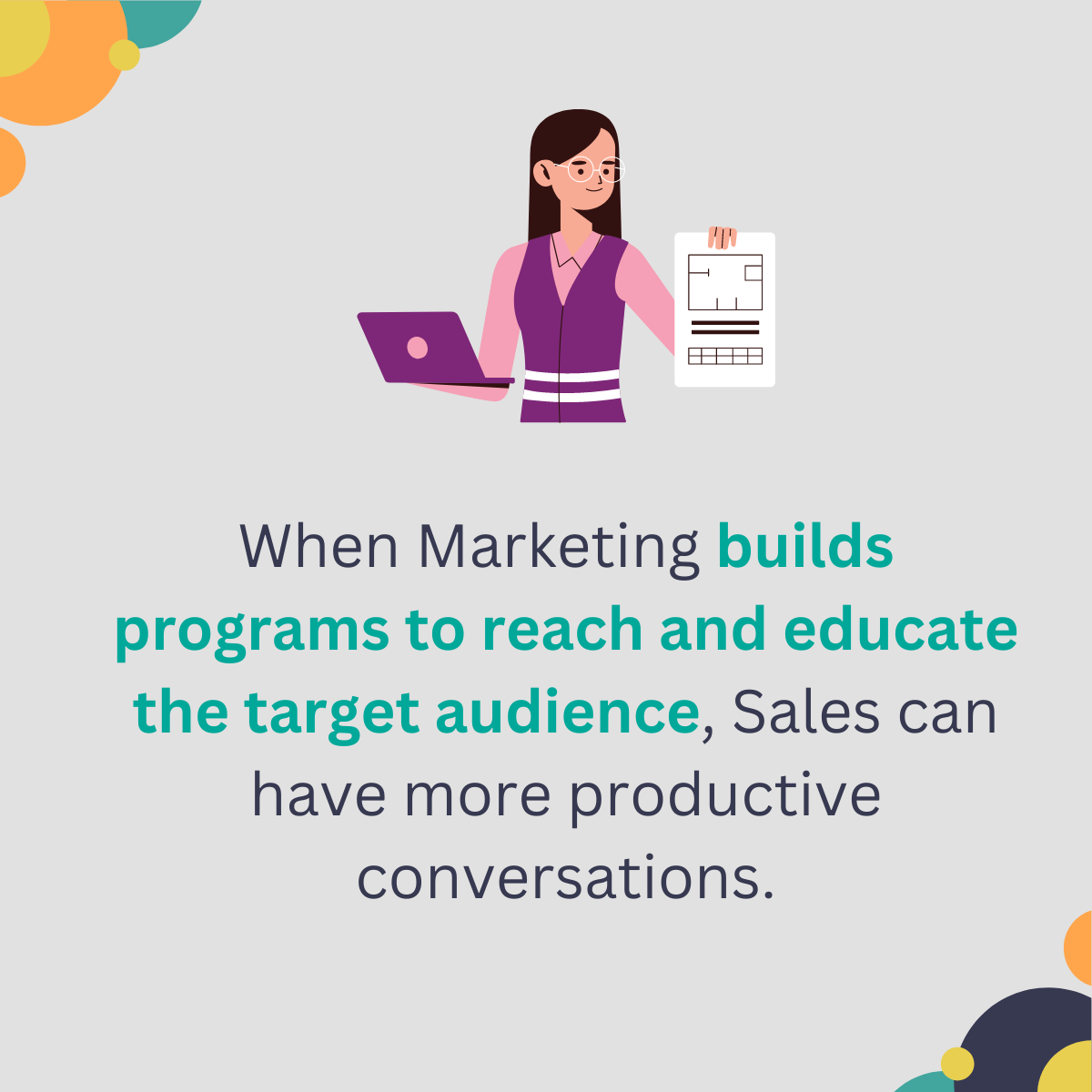Take a Customer-Centered Approach to Collaboration
Bridging the Sales-Marketing Divide Part 3
A comprehensive approach to bridging the Great Sales-Marketing Divide centers the work of both teams in the needs of your customers. Although their roles are different, both Sales and Marketing are serving the same ideal customer. Focusing on that customer promotes collaboration and reduces friction.
Map out the buyer’s journey.
Oftentimes Marketing and Sales remain laser-focused on their respective parts of the go-to-market equation, the marketing funnel and the sales process, at the expense of what should unite them: the buyer’s journey. Breaking the journey into two parts makes sense from an operational standpoint–Marketing and Sales have different roles and responsibilities–but it sometimes creates additional friction between the teams. And, as far as the buyer or customer is concerned, the distinction between the two processes is arbitrary.
Before deciding what Marketing will own or what Sales will do, map out the buyer’s journey. How do buyers determine that they even have a problem to solve? Where do they learn about solutions? What information do they need? Whom do they trust? Conduct buyer persona interviews, starting with current customers, to learn how they make decisions. If you can, conduct formal third-party market research with prospective buyers, as this will eliminate some sample bias.
It’s critical to understand the journey from the buyer’s perspective before you start allocating responsibilities, or you risk setting up processes that don’t align to customer behavior. For example, I know I’m not the only person who receives a high volume of cold outreach on LinkedIn from salespeople who don’t understand how I make decisions. Understanding the buyer’s journey gives you a foundation on which you can build your marketing and sales processes. And Marketing and Sales teams work more collaboratively when they can place their own and each other’s work within the context of the buyer they are both trying to reach.
Build marketing programs based on the audience you want to reach.
Marketing teams often feel pressure to deliver on the requests of internal stakeholders in Sales, not to mention in Product, Customer Success, and the executive team. They also feel anxious about matching the activity of industry competitors. And when the CEO doesn’t fully understand the role of marketing, marketers may rush to demonstrate ROI in ways that are easy to measure.
But when it comes to the true impact of marketing–increasing brand awareness, creating demand, and cultivating customer loyalty–not everything meaningful can be measured in the short term. That’s why it’s so important to place the customer at the center of marketing strategy and planning. Who are the target buyer personas, where do they go to learn about products, and what kind of information do they use to make purchasing decisions?
Develop marketing programs to reach buyers where they are, rather than where internal stakeholders want to see the company name. Then, when your sales team meets with prospective buyers, or it’s time for a current customer to make another purchase, your buyers will be educated on your company and the differentiated value you offer.
How do you know what marketing programs to build? This comes from your persona research. For example, in one set of persona interviews I conducted, I learned that people in the company’s target persona roles used private Facebook groups to share information about products they were considering. As a result, I recommended adjusting the company marketing strategy to include Facebook ads and middle- and bottom-of-funnel content that could easily be shared across platforms.
Buyer persona interviews also make it easier for Marketing teams to justify their program focus and investments to their colleagues in Sales. “Why aren’t we going to that trade show?” Sales might ask. Marketing can respond, “Our buyers have told us that they prefer to learn about new products through smaller networking events. Here are the five events we’ll be hosting.”
Marketing should also explain to Sales that leads can come from a number of channels–events, trade shows, email campaigns, social media, publicity, sponsored content, webinars, website, direct mail, advertising, and so on–and that these channels work together to influence the target audience. It takes multiple impressions to influence a potential buyer to respond to a call to action, and not all impressions will be captured. Don’t focus so closely on the performance of a single channel or tactic that you blind yourself to the overall effect.
That’s not to say that Marketing should be inflexible to requests from Sales. Because they are continuously talking to prospective buyers, salespeople can detect signs of change in market conditions or buyer behavior. I recommend building some flexibility into the marketing plan, by making 20 to 50 percent of your campaigns placeholders. For industries with a long sales cycle, it can be helpful to allow for up to 50 percent “wiggle room” in the marketing plan, as you don’t want to find yourself locked into stale or underperforming campaigns. Instead, commit to your “big rock” campaigns–the ones deemed critical to achieving business goals–and then develop the remainder in response to market conditions and buyer behavior.
Allowing for flexibility within the plan also leads to a better, more collaborative relationship between Sales and Marketing. Sales can help execute the plan Marketing has established but has a clear opening to bring their on-the-ground insights back to the Marketing team. And both the marketing plan and the marketing programs are grounded in the reality of the customer.
Develop onboarding and sales readiness programs.
All too often new salespeople are expected to learn as they go, without a formal onboarding program. They may be assigned to a manager or a team veteran for mentoring; their mentor will share what they have learned through their years at the company, which may or may not include the most recent market insights, persona research, marketing collateral, or sales pitch deck. Company leaders might congratulate themselves on the economy of this arrangement while wondering why Sales and Marketing are constantly at loggerheads. The Product team will meanwhile agonize over why Sales is not promoting the latest version of the product.
Let me share a universal truth with you: Regardless of company size or phase of growth, there will always be new salespeople. It is therefore in everyone’s best interest to develop an onboarding program for new salespeople. Similarly, as your product, industry, market, and customer needs evolve, there will always be something new that your salespeople should know. You need a sales readiness program for your tenured salespeople as well.
Regardless of who owns the sales enablement function within the company, Marketing has a critical role to play in educating Sales colleagues on customer needs, market trends, product developments, competitive advantages, and key messages. The absence of onboarding and sales readiness programs can create a significant drag on the Marketing organization, as Marketing team members are repeatedly called in to answer one-off questions about campaigns and collateral. The resentment Marketing feels over this arrangement does nothing to aid the Sales-Marketing relationship.
Dedicated onboarding and sales readiness programs ensure salespeople meet a standard for understanding customer needs and responding to customer questions throughout the sales process. They also provide a channel for Marketing to keep Sales colleagues up to speed on new campaigns and collateral to share with prospective and current customers. Carving out programs for both onboarding and sales readiness promotes accountability and also protects the time Marketing needs to think and plan strategically.
Create space to hear from your customers.
One of the most effective ways I’ve found to foster collaboration between Marketing and Sales is to create opportunities where they can hear directly from customers together. This might be accomplished by regularly convening a customer advisory board, organizing a customer panel for the annual sales kickoff, or simply having Marketing team members join salespeople on sales calls. Making these listening activities a joint exercise helps Marketing and Sales team members come to a shared understanding of customer needs.
The learning that comes from time spent with customers is an example of what the Pragmatic Institute calls the “NIHITO principle,” where NIHITO stands for “nothing interesting happens in the office.” When Marketing folks stay in their offices with limited interaction with customers, they risk losing touch with the audience they serve–and Sales colleagues will be the first to notice, and comment, on it.
Technology makes it easier than ever for Marketing team members to hear from customers. Real-time interaction is best, as it creates space for Marketing and Sales to discuss what they heard immediately afterward, but listening to recordings of sales calls is still an effective way for Marketing to learn what customers’ greatest challenges are, and what they are looking for in a solution.
Customer calls can also serve as a source of inspiration. Whenever I’ve gone on the road with a Sales colleague, I’ve returned to my desk brimming with ideas for campaigns, collateral, and product development–as well as a deeper sense of empathy and respect for the struggles and successes of my Sales counterparts.
Conclusion
The relationship between Sales and Marketing can be a challenging one. Some conflict may arise when company goals or strategy are unclear, but there is also a natural tension between teams due to the differences in their roles and motivations. When properly managed, these differences can be a productive friction that drives results. SLAs can improve the Sales-Marketing relationship by establishing goals for each team, defining lead stages, and promoting accountability, but they are focused on internal processes rather than the customer both groups are trying to reach. Sales and Marketing leaders can bridge the Great Divide by centering their work in the customer’s reality.



